Black and Yellow Bugs (With Pictures) – Identification Guide
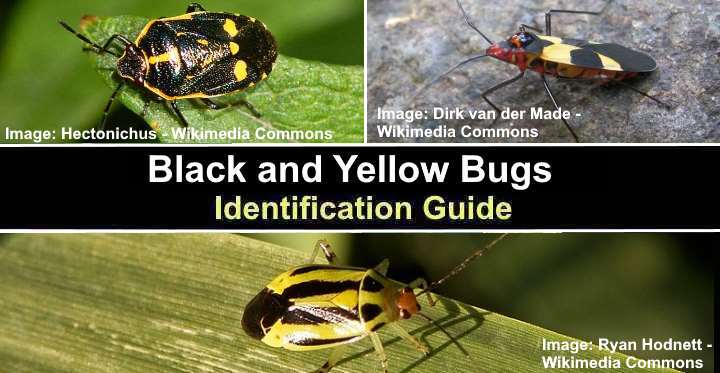
Black and yellow bugs are relatively uncommon because most bugs are black or brown. However, you may find several species of bugs with black and yellow bodies in your yard or home. Some types of black and yellow bugs have stripy bodies. However, other pesky insects have distinctive yellow markings on their jet-black abdomens or yellow wings covered with black spots.
Many people refer to any type of annoying black and yellow insects as bugs. Therefore, wasps, hornets, striped cucumber beetles, yellowjackets, and hoverflies get grouped together as black and yellow bugs. However, these insects — although highly irritating — are not bugs in the true sense of the word.
Have you spotted a yellow and black critter scurrying across the floor or crawling on plants in your garden? Or maybe black and yellow flying insects are a nuisance in the yard. In that case, it’s crucial to identify the bugs to know how to deal with them.
There are several types of black and yellow bugs, each with its own characteristics. This guide will teach you how to identify black and yellow bugs, including their common names, pictures, descriptions, habitats, and behavior.
How to Identify Black and Yellow Bugs
To identify black and yellow bugs, take note of their body shape, markings, size, and type of antennae. For example, the bugs could have stripes, spots, or irregular patterns on their backs. Also, the head and thorax could be a different color from the rest of the insect.
Bugs are identified as six-legged insects with two antennae in the order Hemiptera. Individual bug species are grouped into suborders, families, and genera. All bugs have a characteristic piercing and sucking mouthpiece they use to bite into plant tissue or flesh.
Bugs vs. Insects — What’s the Difference?
Bugs and insects aren’t the same things scientifically. Although both are classified as arthropods in the class Insecta, not all insects are true bugs. Bugs belong to the order Hemiptera. They differ from other insects because bugs have a piercing mouthpiece they use to suck sap from plants or blood from animals.
Insects, including bugs, typically have six legs, two antennae, and a three-section body consisting of a head, thorax, and abdomen. In addition, many insects and bugs have wings, although not all species fly.
The difference between bugs and insects gets confusing because some insects have bugs in their common name. For example, June bugs and ladybugs are types of beetles but are not true bugs.
Furthermore, most people call any type of small, invasive creature a bug. Therefore, spiders, bees, moths, cockroaches, fleas, and mosquitos are all called bugs because they are common nuisance pests. However, true bugs are bed bugs, stink bugs, cicadas, and shield bugs.
This article contains identifying features of common types of true bugs with black and yellow colors. You’ll learn about cotton stainer bugs, crucifer shield bugs, black and yellow stink bugs, four-lined plant bugs, and the harlequin bug.
However, at the end of the article, you’ll find out about black and yellow insects people call bugs, even though they are not members of the order Hemiptera.
Tiny Black and Yellow Bugs
A few species of tiny black and yellow bugs exist. Typically, these six-legged insects have black and yellow stripes or yellow spots on a tiny black body. These minuscule insects usually measure less than 0.30” (7.5 mm) long.
The tiniest black and yellow bugs in the order Hemiptera are the crucifer shield bug (Eurydema oleracea) and the four-lined plant bug (Poecilocapsus lineatus).
Small Black and Yellow Bugs
Most species of black and yellow bugs are small insects measuring between 0.30” and 0.78” (7.5 – 20 mm). The small bugs usually have yellow, shield-shaped bodies with black markings. In addition, some small black and yellow bugs have broad abdomens, whereas others have slender, elongated ones.
The yellow man-faced stink bug (Catacanthus incarnatus) and the cotton stainer bug (Dysdercus cingulatus) are two species of common small bugs with black and yellow bodies.
Black and Yellow Bugs — With Pictures and Identification Guide
Only a few species of black and yellow bugs belong to the order Hemiptera. After discussing the descriptions and pictures of these bugs, we’ll look at other black and yellow insects many people consider to be bugs.
Four-Lined Plant Bug (Poecilocapsus lineatus)
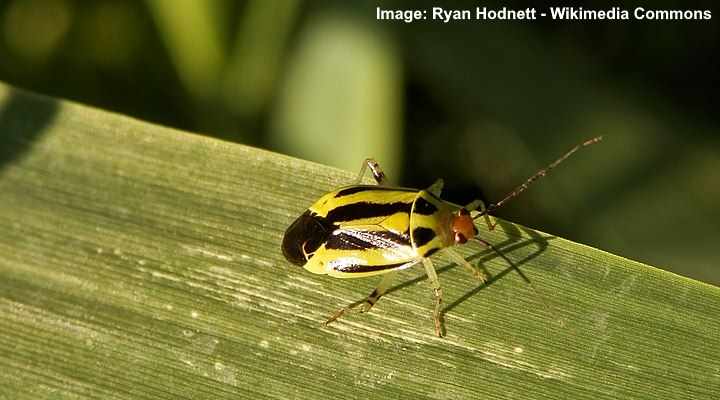
The tiny four-lined plant bug can be identified by its striped black and yellow body, black patch at its tail and brown head
The four-lined plant bug is a tiny insect identified by a black and yellow striped abdomen, thorax, and brown head. Distinguishing features of the black and yellow bug are four distinct black lines on yellow wing covers and a black tear-shaped mark at its tail. In addition, the brightly-colored yellow thorax has four black spots.
Four-lined plant bugs are true bugs in the order Hemiptera. The black-striped, yellow bugs measure 0.28” to 0.30” (7 – 7.5 mm) long and 0.14” (3.5 mm) wide. There are also color variations, with some species being orange and black striped bugs.
The life cycle of four-lined plant bugs starts as an egg that hatches in spring. Larvae and nymphs grow rapidly before becoming brightly-colored yellow and black or orange and black oval-shaped bugs. The bugs are common throughout North America.
The bugs can become pests on herbaceous plants and also feed on the leaves of dogwood, forsythia, sumac, and hydrangea plants.
Cotton Stainer Bug (Dysdercus)
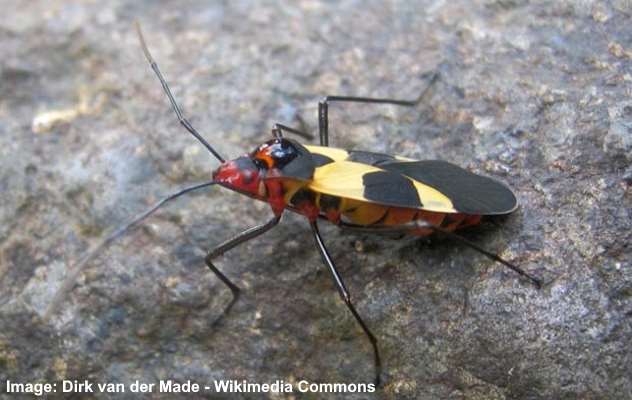
The cotton stainer is a small bug with elongated black and yellow body and a red head
The cotton stainer bug is a narrow yellow and black bug with an elongated shape, black legs, black antennae, and a red head. The small bugs have distinctive black marks on yellowish wing pads, making them easy to identify. This small bug also has spindly legs and slender antennae.
Adult cotton stainer bugs grow 0.60” (15 mm) long. From above, the markings on the wing covers (elytra) show a tear-shaped mark at the tail end, two large black dots in the middle, and a small triangular black patch just behind the thorax. Underneath, the bugs have distinctive red bodies with white stripes.
Cotton stainer bugs get their name because they are a significant pest of cotton plants. The bugs feed on cotton seeds and bolls, transmitting staining fungi as they feed. Like all true bug species, cotton stainer bugs bite the soft tissue of host plants and suck juices from them.
The yellow and black bugs are native to southern Florida, Mexico, and Central America. In addition to the bugs being a pest for cotton crops, they can also attack ornamental shrubs, tropical hibiscus, eggplant, and oleander blossoms.
Crucifer Shield Bug (Eurydema oleracea)
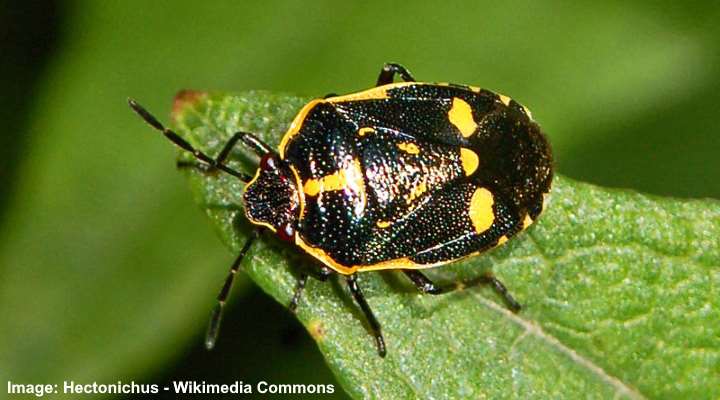
The flattened tiny black body of the crucifer shield bug has yellow spots and a yellow line around its margin
The crucifer shield bug is identified by its glossy black shield-shaped abdomen with three yellow spots and a thin yellow line around its margin. Like most species of shield bugs, this bug has a flat body, small head, and thread-like antennae. As the bug matures, the yellow spots become white or red.
The crucifer shield bug is a tiny black and yellow bug measuring 0.20” to 0.28” (5 – 7 mm) long.
Also called the cabbage bug, rape bug, or brassica bug, the pesky creepy crawly is active from late spring through summer. The glossy black bug feeds on plants in the family Brassicaceae, including cabbage, turnip, radish, and rape seed.
The life cycle of the crucifer shield bug starts as a small tan-colored egg the females lay in early spring. The nymph bugs are pale gray with spots along their abdomen. The minor adult shield bugs are easily seen on plants. The adults overwinter in leaf debris.
Yellow Man-faced Stink Bug (Catacanthus incarnatus)
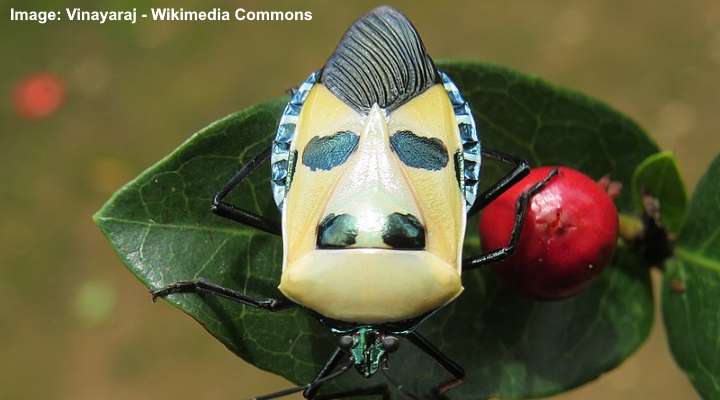
The yellow man-faced stink bug has a relatively large pale yellow body with four black spots and a black patch at the tail
The yellow man-faced stink bug is a pale-yellow insect with four identifiable black -spots on its shield-shaped body. This fascinating small yellow and black bug has an iridescent green head, bulging eyes, two slender antennae, and sizable black legs. Color variations include orange, cream-colored, and red bugs.
Adult man-faced yellow stink bugs grow 1” to 1.18” (25 – 30 mm) long, making them a large type of yellow and black bug. Other identifying features of the man-faced stink bug include its white underside with black marks and a sizable black triangular patch at its tail.
Yellow man-faced stink bugs can be plant-destroying pests when active in late spring and summer. The large, hard-shelled insects target the tender shoots and fruit of many plant varieties. They use their piercing mouthparts to bite and then suck the juice from plants.
Although stink bugs are harmless to humans, the large oval, yellow and black bugs emit a foul odor when they feel threatened. This can make eradicating them from gardens challenging. Man-faced stink bugs don’t bite people but are poisonous to birds and other predators and have an unpleasant taste as a defense mechanism.
Harlequin Bug (Murgantia histrionica)
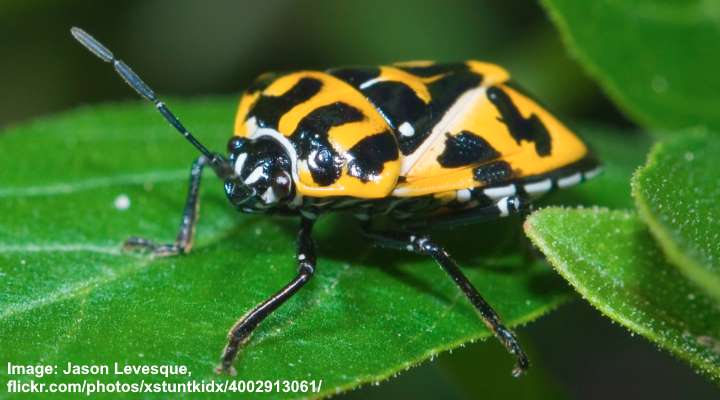
The black and yellow harlequin bug is a garden pest that feed on brassica crops
The harlequin bug is a black and yellow, oval-shaped insect in the true bug order Hemiptera. The brilliantly-colored black bug with yellow markings has a rounded black and white face and white underside with black stripes. They also have segmented black antennae and six black legs.
Also called the fire bug, harlequin cabbage beetle, or calico bug, the rounded, oval insects grow to 0.37” (9.5 mm) long. As the common name suggests, the small pesky garden bugs feed on cabbage plants and related brassica crops. Unfortunately, like all true bugs, the harlequin bug damages plants by sucking their juices.
Handpicking the pests is the best way to eradicate harlequin bugs and other large plant-destroying insects like Colorado beetles and cucumber beetles. However, this requires vigilance to control their numbers.
Hoverfly (Syrphidae)

There are different species of hoverflies with various black and yellow body patterns and stripes
A hoverfly is a black and yellow insect that looks like a bee. The flying insect is identified by its slender body that has black and yellow stripes. Most hoverfly species have a brown head and thorax; like all flies, they have one pair of wings.
Depending on the species, hoverflies measure between 0.11” and 0.78” (3 – 20 mm).
Far from being a pesky bug, this black and yellow flying insect is essential in a garden’s ecosystem. The flying insects prey on aphids, and they help to pollinate flowers during summer.
Yellowjacket or Yellow Jacket (Vespula)
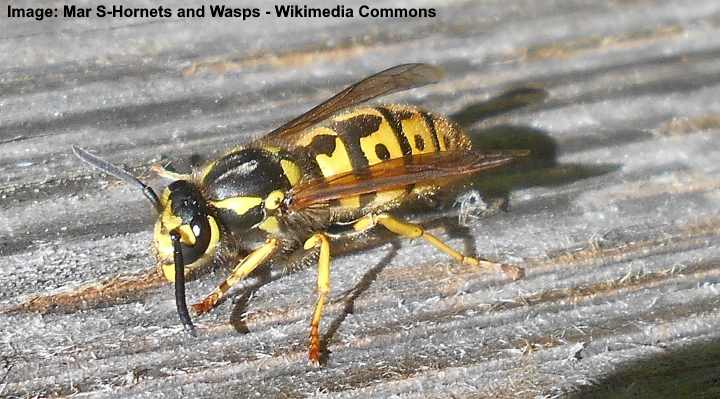
A close up picture of the black and yellow Vespula germanica (European wasp, German wasp, or German yellowjacket) that is well established in the Northern Hemisphere
Many people consider yellowjackets flying black and yellow bugs because they sting and are annoying summer creatures. Yellowjackets have a black and yellow striped body, yellow legs, and a flat, yellow face with large compound eyes. Unfortunately, these black and yellow wasps also have a stinger that can cause pain and swelling.
Yellowjackets measure 0.47” (12 mm) long. Although the “bugs” can cause distress to humans if they sting, they are important pollinators and also feed on common plant pests.
Hornets
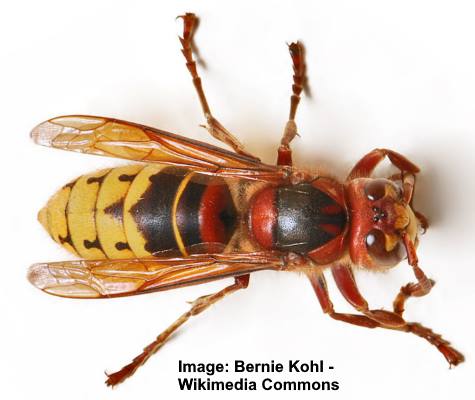
European hornets (Vespa crabro) have black and yellow bee-coloring but are much larger than bees
Hornets can be menacing black and yellow bugs because of their size, ability to sting, and aggressive nature. Hornets are related to yellowjackets and other wasps; therefore, they are not true bugs. These giant flying insects can measure between 1.5” and 2” (38 – 50 mm). A hornet’s primary coloration is dark brown and yellow stripes, but there are various species with a different coloration.
Cucumber Beetles (Acalymma vittatum and Diabrotica undecimpunctata howardi)
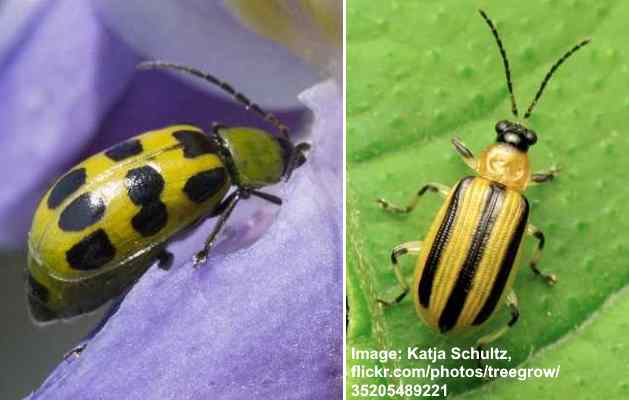
Cucumber beetles: Left picture: Spotted cucumber beetle (Diabrotica undecimpunctata). Right: striped cucumber beetle (Acalymma vittatum)
Cucumber beetles can be annoying pests in a vegetable patch as the annoying black and yellow striped or spotted bugs destroy plant foliage. The small yellow oval insects have a domed shape and brightly colored wing cases. One yellow species has black stripes, whereas the other has black spots.
The striped cucumber beetle has an oval body with ridged yellow elytra and three identifiable black stripes. The tiny destructive pest has a yellow thorax and black head that is noticeably smaller. Additionally, it has greenish-yellow legs with black bands.
The spotted cucumber beetle looks more like a yellow and black ladybug. The tiny beetle has smooth, domed yellow elytra with five or six black patches. Its thorax is somewhat green and has a small black head, legs, and antennae.
The small black and yellow beetles that look like bugs measure between 0.19” and 0.37” (5 – 9.5 mm).
22-Spot Ladybug (Psyllobora vigintiduopunctata)
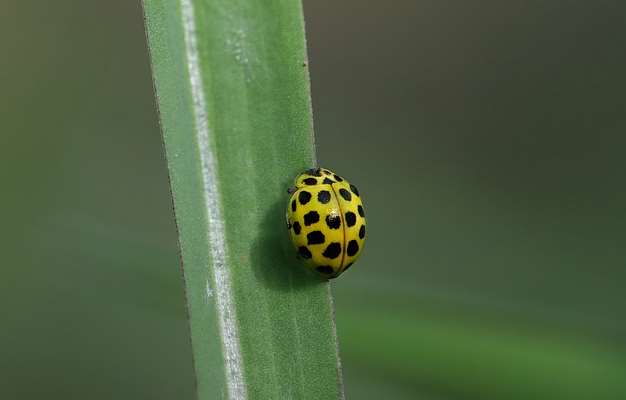
The tiny 22-spot ladybird has a yellow rounded body with black spots
Although called a bug, the 22-spot ladybug is a type of yellow and black beetle. The bug-like beetle has a domed, bright yellow body with 11 spots on each wing cover. Closeup pictures show the yellow beetle’s pronotum (the shield covering the thorax) has five black spots.
The black-spotted yellow ladybug beetle measures 0.19” (5 mm) long. The beetles are found on the underside of shrub foliage, where they feed on mildew.
Black and Yellow Longhorn Beetles (Cerambycidae spp.)
Many species of longhorn beetles are often mistaken for yellow and black bugs or types of wasps. The black beetles are identified by their yellow bands across the black elytra. The black and yellow “bugs” have characteristic long, curved thread-like antennae that are longer than their bodies.
Here are some species of longhorn beetles (also called longicorns) that have black and yellow colors:

Flower Longhorn Beetle (Typocerus sparsus)
Flower Longhorn Beetle (Typocerus sparsus): The slender black beetle has yellow horizontal stripes, brown legs, head, and antennae. This yellow-striped, black beetle measures 0.43” (11 mm). You’ll find this wasp-like beetle feeding on flower nectar and pollen in parks, woodlands, and backyards.
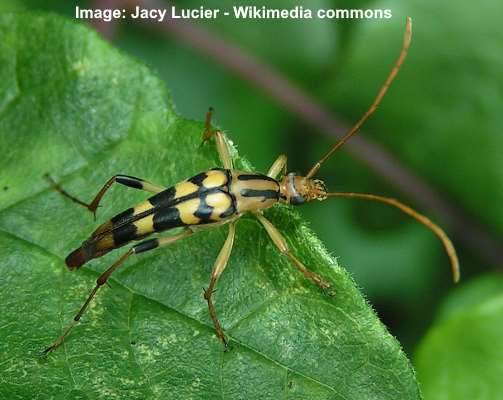
Yellow-Horned Flower Longhorn Beetle (Strangalia luteicornis)
Yellow-Horned Flower Longhorn Beetle (Strangalia luteicornis): The easily identifiable flower longhorn has a slender body that tapers at its tail end. The beetle’s coloration is black and yellow, and it has a brown head and arching antennae. The yellow-horned flower longhorn beetle measures 0.35” to 0.55” (9 – 14 mm) long.

Spotted Longhorn Beetle (Rutpela maculata)
Spotted Longhorn Beetle (Rutpela maculata): This yellow longhorn beetle with black markings has an elongated body, long black thorax, and a small head. Identifying features of his beetle are its black and yellow banded antennae and legs. The yellow spotted longhorn beetle measures 0.5” to 0.78” (13 – 22 mm).
Rose Chafer Beetle (Eupoecila australasiae)
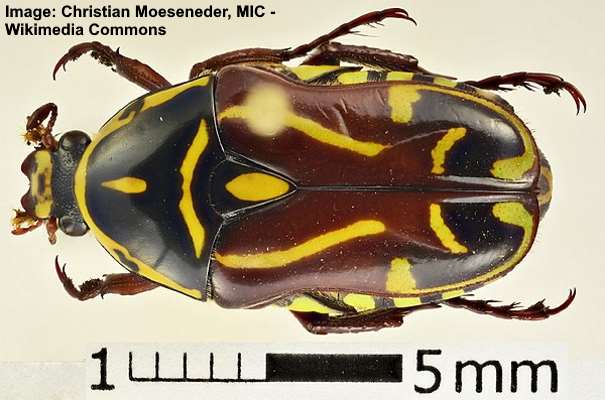
The rose chafer beetle has oval flattened black and brown body with yellow markings and short legs
The rose chafer beetle is a large colorful black and yellow scarab beetle with distinctive wavy yellow markings on its elytra and thorax. This yellow and black beetle is also called the fiddler beetle due to its yellow or green violin-shaped pattern on its back. The rose chafer beetle measures 0.6” to 0.8” (15 – 20 mm) long.
The flattened-bodied black and yellow fiddler beetles feed on flower nectar. As a result, they are often seen flying from flower to flower, playing a crucial role in flower pollination.
Related articles:
